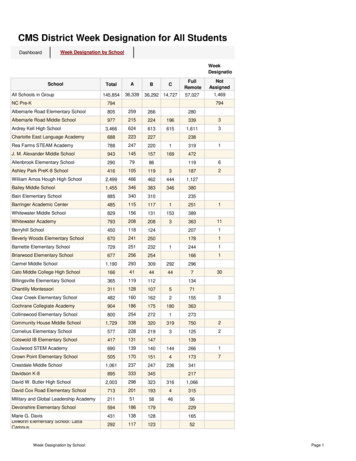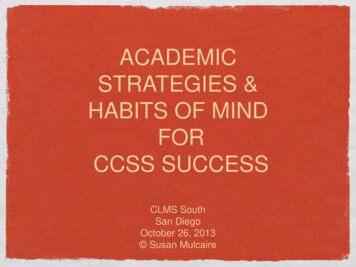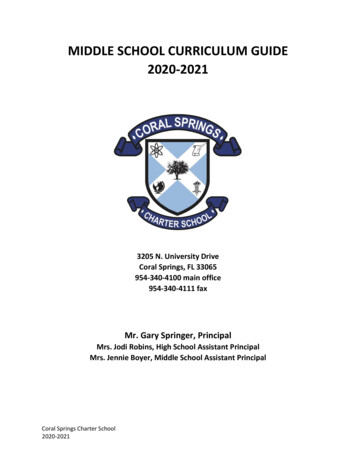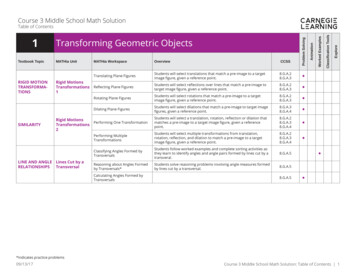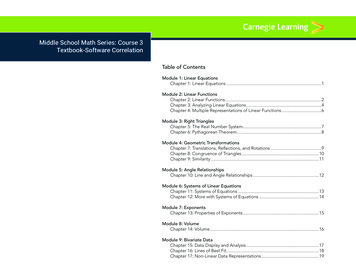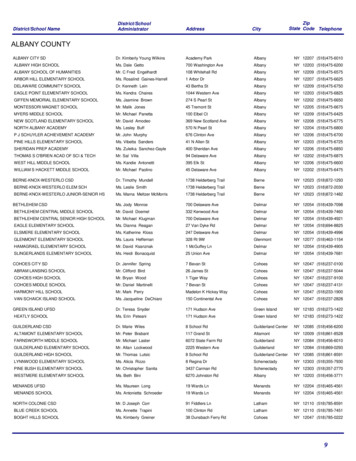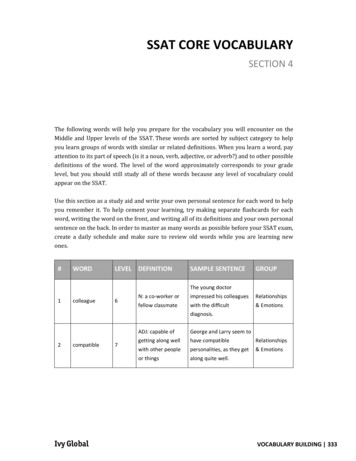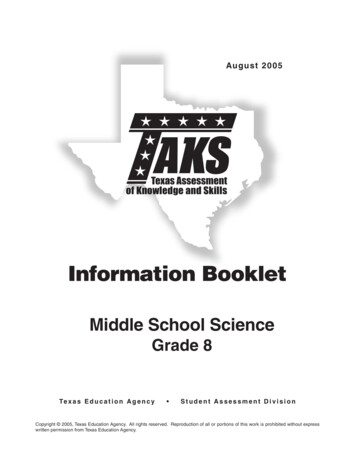
Transcription
August 2005Texas Assessmentof Knowledge and SkillsInformation BookletMiddle School ScienceGrade 8Te x a s E d u c a t i o n A g e n c y Student Assessment DivisionCopyright 2005, Texas Education Agency. All rights reserved. Reproduction of all or portions of this work is prohibited without expresswritten permission from Texas Education Agency.
INTRODUCTIONThe Texas Assessment of Knowledge and Skills (TAKS) is a completely reconceived testing program.It assesses more of the Texas Essential Knowledge and Skills (TEKS) than the Texas Assessment ofAcademic Skills (TAAS) did and asks questions in more authentic ways. TAKS has been developedto better reflect good instructional practice and more accurately measure student learning. We hopethat every teacher will see the connection between what we test on this new state assessment andwhat our students should know and be able to do to be academically successful. To provide you witha better understanding of TAKS and its connection to the TEKS and to classroom teaching, the TexasEducation Agency (TEA) has developed this TAKS information booklet. We hope this TAKSinformation booklet will serve as a user-friendly resource to help you understand that the bestpreparation for TAKS is a coherent, TEKS-based instructional program that provides the level ofsupport necessary for all students to reach their academic potential.BACKGROUND INFORMATIONThe development of the TAKS program included extensive public scrutiny and input from Texasteachers, administrators, parents, members of the business community, professional educationorganizations, faculty and staff at Texas colleges and universities, and national content-area experts.The agency took these steps to involve as many stakeholders as possible because we believed that thedevelopment of TAKS was a responsibility that had to be shared if this new assessment was to be anequitable and accurate measure of learning for all Texas public school students.The three-year test-development process, which began in summer 1999, included a series of carefullyconceived activities. First, committees of Texas educators identified those TEKS student expectationsfor each grade and subject area assessed that should be tested on a statewide assessment. Then acommittee of TEA Student Assessment and Curriculum staff incorporated these selected TEKSstudent expectations, along with draft objectives for each subject area, into eleventh-grade exit levelsurveys. These surveys were sent to Texas educators at the middle school and secondary levels fortheir review. Based on input received from more than 57,000 survey responses, we developed asecond draft of the objectives and TEKS student expectations. In addition, we used this input duringthe development of draft objectives and student expectations for grades 3 through 10 to ensure thatthe TAKS program, like the TEKS curriculum, would be vertically aligned. This vertical alignmentwas a critical step in ensuring that the TAKS tests would become more rigorous as students movedfrom grade to grade. For example, the fifth-grade tests would be more rigorous than the fourth-gradetests, which would be more rigorous than the third-grade tests. Texas educators felt that this increasein rigor from grade to grade was both appropriate and logical since each subject-area test was closelyaligned to the TEKS curriculum at that grade level.Each year a panel of recognized experts in the fields of English language arts (ELA), mathematics,science, and social studies meet in Austin to critically review the content of each of the high schoollevel TAKS assessments to be administered that year. This critical review is referred to as a contentvalidation review and is one of the final activities in a series of quality-control steps to ensure thateach high school test is of the highest quality possible. A content validation review is considerednecessary at the high school grades (9, 10, and 11) because of the advanced level of content beingassessed.Grade 8 TAKS Science Information Booklet1
MIDDLE SCHOOL SCIENCE TAKSThe test development process for middle school science assessment began in summer 2003. Acommittee of TEA Student Assessment and Curriculum staff developed a tentative draft of testobjectives and student expectations from the TEKS that might best represent the middle schoolscience curriculum. This draft was presented to hundreds of Texas educators from across the statewho gave recommendations for additions and deletions. These recommendations were thenincorporated into an educator survey, which was sent to middle schools across the state. This surveyfocused on two central issues: first, whether the objectives included in the draft were essential tomeasure on a statewide assessment, and second, whether students would have received enoughinstruction on the TEKS student expectations included under each objective to be adequately preparedto demonstrate mastery of that objective in the spring of their eighth grade school year. The surveywas also made available online. Based on input received from middle school survey responses, a finaldraft of the objectives and student expectations was developed.ORGANIZATION OF THE TAKS TESTSTAKS is divided into test objectives. It is important to remember that the objective statements are notfound in the TEKS curriculum. Rather, the objectives are “umbrella statements” that serve asheadings under which student expectations from the TEKS can be meaningfully grouped. Objectivesare broad statements that “break up” knowledge and skills to be tested into meaningful subsets aroundwhich a test can be organized into reporting units that help campuses, districts, parents, and thegeneral public understand the performance of our students and schools. Test objectives are notintended to be “translations” or “rewordings” of the TEKS. Instead, the objectives are designed to beidentical across grade levels rather than grade specific. Certain TEKS student expectations maylogically be grouped under more than one test objective; however, it is important for you tounderstand that this is not meaningless repetition—sometimes the organization of the objectivesrequires such groupings. For example, on the TAKS writing tests for fourth and seventh grades, someof the same student expectations addressing the conventions of standard English usage are listedunder both Objective 2 and Objective 6. In this case, the expectations listed under Objective 2 areassessed through the overall strength of a student’s use of language conventions on the writtencomposition portion of the test; these same expectations under Objective 6 are assessed throughmultiple-choice items attached to a series of revising and editing passages.ORGANIZATION OF THE INFORMATION BOOKLETSThe purpose of the information booklets is to help Texas educators, students, parents, and otherstakeholders understand more about the TAKS tests. These booklets are not intended to replace theteaching of the TEKS curriculum, provide the basis for the isolated teaching of skills in the form ofnarrow test preparation, or serve as the single information source about every aspect of the TAKSprogram. However, the booklets provide helpful explanations as well as show enough sample items,reading and writing selections, and prompts to give educators a good sense of the assessment.Each grade within a subject area is presented as a separate booklet. However, it is still important thatteachers review the information booklets for the grades both above and below the grade they teach.Grade 8 TAKS Science Information Booklet2
For example, eighth-grade mathematics teachers who review the seventh-grade information bookletas well as the ninth-grade information booklet are able to develop a broader perspective of themathematics assessment than if they study only the eighth-grade information booklet.The information booklets for each subject area contain some information unique to that subject. Forexample, the mathematics chart that students use on TAKS is included for each grade at whichmathematics is assessed. However, all booklets include the following information, which we considercritical for every subject-area TAKS test:an overview of the subject within the context of TAKSa blueprint of the test—the number of items under each objective and the number of items on thetest as a wholeinformation that clarifies how to read the TEKSthe reasons each objective and its TEKS student expectations are critical to student learning andsuccessthe objectives and TEKS student expectations that will be included on TAKSadditional information about each objective that will help educators understand how it isassessed on TAKSsample items that show some of the ways objectives are assessedGrade 8 TAKS Science Information Booklet3
What Every Teacher Needs to Know About the TAKS Science TestsWhy do we test science?As teachers and parents, we are preparing our children to be the next generation of educated andconcerned citizens. An understanding of science will help our children be better informed and morecapable of making decisions that will affect their lives and the environment. Being scientificallyliterate cannot be defined as simply having the ability to remember scientific facts. Scientific literacymeans that our students will not only understand important science concepts but also be able to applywhat they know to the health, safety, and environmental issues that are at the center of our everydaylives. Science assessments play a critical role in determining whether our students are mastering thescience knowledge and skills they need in order to be scientifically literate and academicallysuccessful.What is the science TAKS based on?The TAKS is based on the state-mandated science curriculum, the Texas Essential Knowledge andSkills (TEKS). All four science assessments were developed using selected knowledge and skillsstatements and student expectations from the science TEKS. The elementary science test is based oneligible science TEKS from grades 2–5. The middle school science test is based on selected scienceTEKS from grades 6–8. The grade 10 and exit level TAKS tests are based on selected TEKS forIntegrated Physics and Chemistry (IPC) and Biology.The TEKS were created to align closely with the National Science Education Standards, Benchmarksfor Science Literacy, and Science for All Americans. These books are excellent resources for guidancein finding grade-appropriate strategies for teaching many science concepts. These nationallyrecognized documents may also help educators understand the depth and complexity of the TEKS.How were the TEKS chosen to be on the grade 8 TAKS science test?The middle school science TEKS knowledge and skills statements and student expectations eligiblefor assessment were determined to be appropriate for TAKS by Texas science educators. StudentAssessment and Curriculum staff from TEA received input from approximately 500 educators at theTexas Science Education Leadership Association (TSELA) Conference and the 2004 Conference forthe Advancement of Science Teaching (CAST). In addition, TEA used feedback from approximately1,400 campus concensus surveys as well as from a middle school science educator committee tofinalize the objectives and TEKS student expectations eligible for assessment of grade 8. Althoughsome student expectations within the TEKS are not assessed, it is important that educators teach allthe science curriculum so that students can develop a complete understanding of critical scienceconcepts.How are the TEKS organized within the TAKS?The knowledge and skills statements, with their associated student expectations, are organized underobjectives on the TAKS. These objectives group the eligible student expectations into categories withsimilar content and are used for score-reporting purposes. The elementary science test has fourobjectives, while the middle school, grade 10, and exit level tests have five objectives.Grade 8 TAKS Science Information Booklet4
How do the knowledge and skills statements relate to items on the TAKS science tests?Every item developed for the TAKS is grounded in the knowledge and skills statements. For example,in student expectation 8.9(A), “The student is expected to demonstrate that substances may reactchemically to form new substances.” This concept will be assessed within the framework of theoverriding knowledge and skills statement, which reads, “The student knows that substances havephysical and chemical properties.”Concepts may be “unbundled” within the knowledge and skills statement or the student expectation.That is, items may assess concepts individually and not necessarily in relation to one another within astudent expectation. For instance, in Objective 5 (“The student will demonstrate an understanding ofearth and space systems”) the knowledge and skills statement and student expectation (8.10)(B) states,“The student knows that complex interactions occur between matter and energy. The student is expectedto describe interactions among solar, weather, and ocean systems.” However, a particular test item mayaddress only the solar and weather system interactions. It may not include the role of ocean systems.What are “unifying themes”?All educators should work together to align the curriculum across all grade levels so that unifyingthemes of learning are reinforced. TEKS instruction throughout elementary and middle school willlay the foundation for biology, chemistry, physics, and earth science concepts taught in high school.The science TEKS contain unifying themes, or conceptual strands, that are developed across gradelevels in a grade-appropriate progression. To ensure thorough teaching of the TEKS, educators shouldconnect concepts throughout the grade levels and provide varied opportunities for students tounderstand the concepts within a strand.An example of a “systems” strand is given below:(2.9) Science concepts. The student knows that living organisms have basic needs. Thestudent is expected to(B) compare and give examples of the ways living organisms depend on eachother and on their environments. (Tested at grade 5)(7.12) Science concepts. The student knows that there is a relationship betweenorganisms and the environment. The student is expected to(B) observe and describe how organisms, including producers, consumers, anddecomposers, live together in an environment and use existing resources.(Tested at grade 8)Biology (12) Science concepts. The student knows that interdependence and interactionsoccur within an ecosystem. The student is expected to(E) investigate and explain the interactions in an ecosystem including food chains,food webs, and food pyramids. (Tested at grade 10)Grade 8 TAKS Science Information Booklet5
Biology (9) Science concepts. The student knows metabolic processes and energytransfers that occur in living organisms. The student is expected to(D) analyze the flow of matter and energy through different trophic levels andbetween organisms and the physical environment. (Tested at exit level)How are science integrations and interdisciplinary issues handled on the TAKS science tests?It is important for teachers to introduce students to science content in a variety of ways. It is alsoessential for teachers to help students make connections among the science disciplines by showingthe natural integrations among the life, earth, and physical sciences. For example, when studyingdifferent soil types (earth science), students can also learn how nutrients (chemistry) in the soil affectthe types of plants (biology) that grow there.Teachers should emphasize to students that science is not isolated from the other academicdisciplines. The development of reading, writing, and mathematical skills will help studentsunderstand and communicate scientific ideas.Is there a State-Developed Alternative Assessment (SDAA II) for the TAKS science tests?Currently there is not an SDAA II for TAKS science at any grade. The admission, review, anddismissal (ARD) committee can recommend that a student take the grade 5, 8, 10, or exit levelscience assessment, if appropriate. TAKS should be considered first when making assessmentdecisions for students receiving special education services. If the ARD committee determines that theTAKS science tests are not an appropriate assessment for a specific student, then the student must beassessed by a locally determined alternate assessment (LDAA). An LDAA can be a portfolio, amodified released test, a hands-on lab or field activity, or any other locally determined assessmentthat the ARD committee deems appropriate.What is the format of the TAKS science tests?Most items will be in a multiple-choice format with four options. Some multiple-choice items will bewritten as part of a cluster. A cluster will have a stimulus, which may be a diagram, a brief passage, achart, or a combination of these, followed by a series of items that will involve the application ofknowledge and analysis of the given information. Cluster items will appear together on the test, butitems may not always appear on facing pages.A limited number of items will be griddable, requiring students to bubble responses on grids that arethe same as those used in the TAKS mathematics tests. The griddable format is intended to givestudents the opportunity to provide a numerical response appropriate for that item, such as apercentage, or to measure with precision and then determine an appropriate answer independently.Not all griddable items are computation based, and they may appear in any of the five objectives.When computation is involved, the level of precision necessary for an item will be given to thestudent in the item. For instance, an item may direct the student to measure an object to the nearestmillimeter.Grade 8 TAKS Science Information Booklet6
A seven-column grid will be the only type of grid for the Middle School Science—Grade 8 TAKS 777888888999999The decimal on the grid defines the place values of the columns that precede and follow it. Studentsmust record their answer in the columns for the correct place values. If an answer is a whole number,students may add zeros after the decimal, or if the answer is fractional, students may add a zero infront of the decimal. Blank grid spaces before or after the answer may be gridded with zeros withoutaffecting the student’s score.How will the grade 8 TAKS science tests be administered?Currently the grade 8 science test is administered through traditional paper-and-pencil testing.However, the state is exploring the use of online testing, which includes conducting comparabilitystudies examining the online mode and the paper-and-pencil mode. Also being explored is the use of“innovative” item types administered online that include video clips, animations, and color graphics.Online testing, including innovative items, may be utilized in future test administrations. Should thisoccur, information about online testing will be provided via the TEA website.Will any of the TAKS science tests be performance based?The only direct performance testing on the TAKS science tests is using a ruler to measure withprecision. Some items will require students to physically use a ruler to measure a drawing of anobject in centimeters or millimeters. Although precise measurement is the direct performance-basedrequirement, many items are based on lab or field activities that students should have experienced.These lab and field experiences should include the use of lab and field equipment.Remember that when the 20-centimeter paper ruler that accompaniesthe TAKS science test or any measurement item is photocopied, theimage may be distorted, and improper measurements can result.What is the purpose of the highlights that appear after each objective?The highlights that appear after each objective are meant to clarify some of the student expectationsin the TEKS. These highlights focus attention on some of the important aspects of certain studentexpectations and explain how these expectations might be assessed on the TAKS science tests. Thehighlights came from comments and concerns expressed on teacher surveys and in educator meetings.Grade 8 TAKS Science Information Booklet7
Introduction to Middle School Science—Grade 8 TAKSWho will be required to take the Middle School Science—Grade 8 TAKS?All eighth-grade students will be required to take the TAKS middle school science test unlessdetermined by an admission, review, and dismissal (ARD) committee or a language proficiencyassessment committee (LPAC). For more information about ARD and LPAC committees, refer to theARD Committee Decision-Making Process for the Texas Assessment Program and LPAC DecisionMaking Process for the Texas Assessment Program.What TEKS will be included on the Middle School Science—Grade 8 TAKS?The grade 8 TAKS is a comprehensive middle school assessment. Even though the test is given ateighth grade, it includes five objectives that cover science TEKS from grades 6, 7, and 8. A 50-itemscience test will provide an accurate snapshot of students’ understanding of important scienceconcepts taught at middle school. There is an emphasis on Objective 1, which is similar to the TAKSscience tests at grade 5, grade 10, and exit level. Many items make connections across sciencedisciplines: life, physical, and earth/space sciences. These items may integrate more than one scienceobjective.How should the TEKS be approached at the middle school level?Students learn science by doing science. At the middle school level, science process skills and contentcan be learned through integrated activities and hands-on experiences. Students must have a thoroughunderstanding of the background subject matter found in the TEKS at grades 6–8 and should knowhow science is relevant to their everyday lives. Test items are cognitively appropriate for middleschool students and are designed to build on elementary concepts and provide scaffolding to highschool concepts. Students will be tested on a deeper understanding of conceptual ideas than in thefifth grade TAKS test. Items will address student expectations in the context of knowledge and skillsstatements, which are broader themes that culminate at grade 8.How important is middle school science education?The grade 8 TAKS science test should serve as a significant indicator of students’ science knowledgeand skills at the eighth-grade level. In middle school science, students will be given the foundation ofknowledge and skills necessary for the application of scientific concepts throughout their everydaylives and academic experiences. In addition, a mastery of these skills will be necessary for continuedsuccess in high school science.What is the role of the untested TEKS in the middle school assessment?Because of the constraints of a single statewide assessment, not all TEKS can be assessed. Whilesome student expectations are not tested, all the TEKS are critical for students’ overall understandingof science. For example, (7.11), “The student knows that the responses of organisms are caused byinternal or external stimuli. The student is expected to (A) analyze changes in organisms such as afever or vomiting that may result from internal stimuli; and (B) identify responses in organisms toexternal stimuli found in the environment such as the presence or absence of light,” is not directlyGrade 8 TAKS Science Information Booklet8
tested, but students must understand this concept in order to successfully answer items testing (8.6),“The student knows that interdependence occurs among living systems. The student is expected to(A) describe interactions among systems in the human organism; (B) identify feedback mechanismsthat maintain equilibrium of systems such as body temperature, turgor pressure, and chemicalreactions; and (C) describe interactions within ecosystems.” The relationship between organisms thatare composed of several systems maintaining homeostasis (equilibrium) and their role in theenvironment is not fully understood until eighth grade, when it is assessed in the middle school TAKStest. This concept is then more fully explored in high school through Biology (10), “The studentknows that, at all levels of nature, living systems are found within other living systems, each with itsown boundary and limits. The student is expected to (A) interpret the functions of systems inorganisms including circulatory, digestive, nervous, endocrine, reproductive, integumentary, skeletal,respiratory, muscular, excretory, and immune.”Although some student expectations within the TEKSare not assessed, it is important that educators teach allof the science curriculum so that students can develop acomplete understanding of critical science concepts.What types of equipment may be referenced on the TAKS middle school science test?Students will be expected to have experience using all of the tools and equipment commonly used infirst through eighth grades. This includes beakers, test tubes, petri dishes, graduated cylinders,microscopes (dissecting and compound), safety goggles (splash-proof), spring scales, triple-beambalances, metersticks, hot plates, thermometers, models (such as topographic maps and globes),computers, computer probes (for temperature and pH), calculators, timing devices, weatherinstruments, telescopes, and field equipment such as binoculars, dip nets for collection, and water testkits.Will students use calculators on the test?Students will not use calculators on the middle school TAKS science test.What is on the science chart?The science chart has two sides (see pages 14–15). One side has a periodic table appropriate formiddle school, and the other side has a list of commonly used formulas and a 20-centimeter ruler.This resource is provided so that students do not need to memorize this information. Even thoughthese formulas may not be directly addressed in the TEKS, they are important for a completeunderstanding of many physics concepts, such as density, work, and force. Room temperature, boilingpoint, and freezing point values will be provided in items for which these values are needed.Grade 8 TAKS Science Information Booklet9
MIDDLE SCHOOL SCIENCE—GRADE 8TAKS BLUEPRINTNumber of ItemsTAKS ObjectivesObjective 1: Nature of Science14Objective 2: Living Systems and theEnvironment12Objective 3: Structures and Propertiesof Matter6Objective 4: Motion, Forces, and Energy6Objective 5: Earth and Space Systems12Total items on the actual test50Field-test items10Total items on each test form60The middle school science TAKS blueprint will remain the same from one testing cycle to the next.Grade 8 TAKS Science Information Booklet10
A Key to Understanding the TEKSIncluded on Middle School Science—Grade 8 TAKSExample from Objective 3A(6.7, 7.7, 8.9) Science Concepts. The student knows that substances have physical and chemicalproperties. The student is expected to(B) interpret information on the periodic table to understand that [physical] properties areused to group elements (8.9).BDCKEYA.Knowledge and Skills StatementThis broad statement describes what students should know and be able to do for MiddleSchool Science—Grade 8. The number(s) preceding the statement identify the knowledgeand skills statement; in the example above, “(6.7, 7.7, 8.9)” indicates that the knowledge andskills statement is the same for grades 6, 7, and 8. It is important to read the knowledge andskills statement along with the student expectations associated with it for a full understandingof the concept.B.Student ExpectationThis specific statement describes what students should be able to do to demonstrateproficiency in what is described in the knowledge and skills statement. Students will be testedon skills outlined in the student expectation statement.C.(8.9)The number in parentheses indicates the grade level at which the student expectation appears.In the example above, “(8.9)” shows that this student expectation has been taken directlyfrom the grade 8 science TEKS. While the wording of this student expectation is specific tograde 8, similar student expectations also appear in grades 6 and 7 under this sameknowledge and skills statement. Texas educators have determined that the student expectationlisted best represents what students must know and be able to do with regard to the scienceconcepts inherent in the knowledge and skills statement. However, it is important for teachersat grades 6 and 7 to teach the student expectation that corresponds to the one listed so thatstudents have the foundation they need for grade 8 instruction.D.[bracketed text]The student expectation has been presented in its entirety for two reasons: to clarify the linkto the curriculum and to provide background information for test items. However, bracketedtext will not be specifically tested on TAKS.NOTE: The full TEKS curriculum can be found at www.tea.state.tx.us/teks/.Grade 8 TAKS Science Information Booklet11
TEKS STUDENT EXPECTATIONS—IMPORTANT VOCABULARYFor every subject area and grade level, two terms—such as and including—are used to help make theTEKS student expectations more concrete for teachers. However, these terms function in differentways. To help you understand the effect each of the terms has on specific student expectations, we areproviding the following:a short definition of each terman example from a specific student expectation for this subject areaa short explanation of how this term affects this student expectationSuch asThe term such as is used when the specific examples that follow it function only as representativeillustrations that help define the expectation for teachers. These examples are just that—examples.Teachers may choose to use them when teaching the student expectation, but there is no requirementto do so. Other examples can be used in addition to those listed or as re
The middle school science test is based on selected science TEKS from grades 6–8. The grade 10 and exit level TAKS tests are based on selected TEKS for Integrated Physics and Chemistry (IPC) and Biology. The TEKS were created to align closely with the National Science Education Standards, Benchmarks for Science


